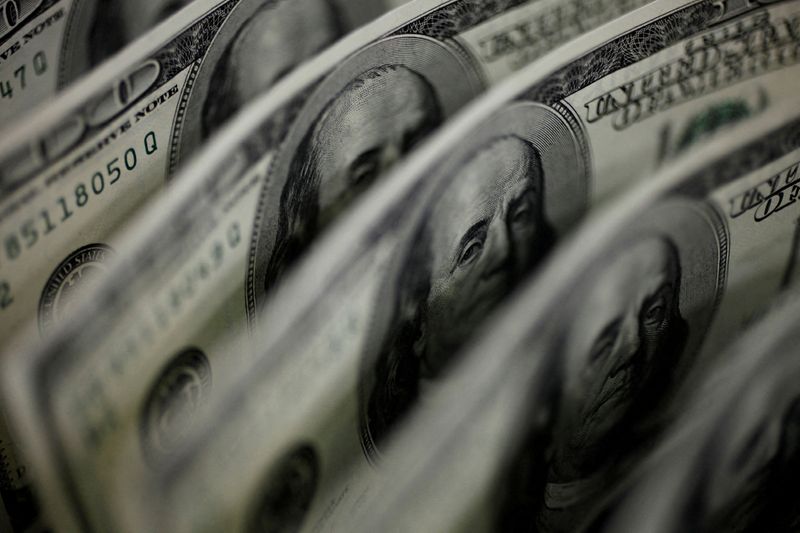Forex
Dollar firm ahead of global inflation data

By Tom Westbrook and Amanda Cooper
SINGAPORE/LONDON (Reuters) -The dollar held steady on Monday, but was set for its first monthly loss this year, as investors were focused on U.S., European and Japanese inflation data to guide the global interest rate outlook.
Foreign exchange trade has been dominated by the hunt for “carry” in recent months, punishing low-yield currencies and supporting the dollar, while U.S. data has blown hot and cold and dented policymakers’ confidence on the rates outlook.
Several major pairs have hugged tight ranges. The euro, which gained 0.9% on the dollar last week, was in the middle of a range it has held for more than a year at $1.0845.
The euro offered little reaction to a survey on Monday that showed German business confidence worsened in May, against forecasts for an improvement.
Trading on Monday was thinned out by holidays in Britain and the United States.
German inflation data on Wednesday and euro zone readings on Friday will be watched for confirmation of a European rate cut that traders have pencilled in for next week.
ECB chief economist Philip Lane said on Monday the pace at which the central bank cuts rates will depend on the strength of underlying inflation.
Sterling was testing the top side of a range it has held this year at $1.2745.
Friday’s reading for the U.S. core personal consumption expenditures price index, the Federal Reserve’s preferred inflation measure, is expected to be steady month-on-month.
The dollar had fallen back after data showed a slowdown in consumer price rises in April and confirming the trend could pull it lower still – but the big picture is that inflation and inflation indicators remain above the Fed’s 2% target.
The , which measures the performance of the U.S. currency against six others, was last down modestly at 104.72. It is on track for a drop of 1.5% in May, the most in one month since December.
“A 25-bp (basis point U.S. interest rate) cut in September is priced at a 50/50 proposition, with a total of 57 bps of cuts priced by December – so we’d need a big surprise to change that pricing,” Pepperstone strategist Christ Weston said.
“U.S. core PCE above 3% could do the trick, and that would get the dollar humming along, while a print below 2.7% could see relief resonate through markets,” he said.
CARRY ON
While the rates uncertainty persists, investors have been chasing income and selling low yield currencies such as the yen, yuan and Swiss franc against the euro and the dollar.
The yen may seal its first monthly gain of the year this month thanks to suspected intervention from Japanese authorities towards the end of April and at the start of May, but it has been slipping back since then.
It was steady at 156.86 to the dollar on Monday but has won little support from rising Japanese government bond yields – at the 10-year tenor, for example, they remain nearly 350 basis points below U.S. yields.
Tokyo CPI data, due on Friday, is a reliable guide to the national trend and will be closely watched. Finance ministry data on Friday will also reveal the size of Japan’s intervention.
The U.S. move to shorten equity-market settlement from two days to one is another factor to watch in currency trade this week as dealers expect it may drive trade into the quiet early mornings in Asia.
“Asia-based investors will only have a few hours to aggregate funding requirements, process trade-related FX instructions and manage the execution,” said Lloyd Rees, global custody product lead for Asia and the Middle East at BNY Mellon (NYSE:).

In cryptocurrency markets, ether closed out its largest weekly rise in nearly three years after a surprise approval for some U.S. exchange-traded fund (ETF) applications.
Further approvals remain necessary before launch, but the price of the second-biggest cryptocurrency by market value rose 25% against the dollar last week and another 5% to $3,938 in Asia trade on Monday.

 Forex3 years ago
Forex3 years agoForex Today: the dollar is gaining strength amid gloomy sentiment at the start of the Fed’s week

 Forex3 years ago
Forex3 years agoUnbiased review of Pocket Option broker

 Forex3 years ago
Forex3 years agoDollar to pound sterling exchange rate today: Pound plummeted to its lowest since 1985

 Forex3 years ago
Forex3 years agoHow is the Australian dollar doing today?

 Cryptocurrency3 years ago
Cryptocurrency3 years agoWhat happened in the crypto market – current events today

 World3 years ago
World3 years agoWhy are modern video games an art form?

 Commodities3 years ago
Commodities3 years agoCopper continues to fall in price on expectations of lower demand in China

 Economy3 years ago
Economy3 years agoCrude oil tankers double in price due to EU anti-Russian sanctions





















